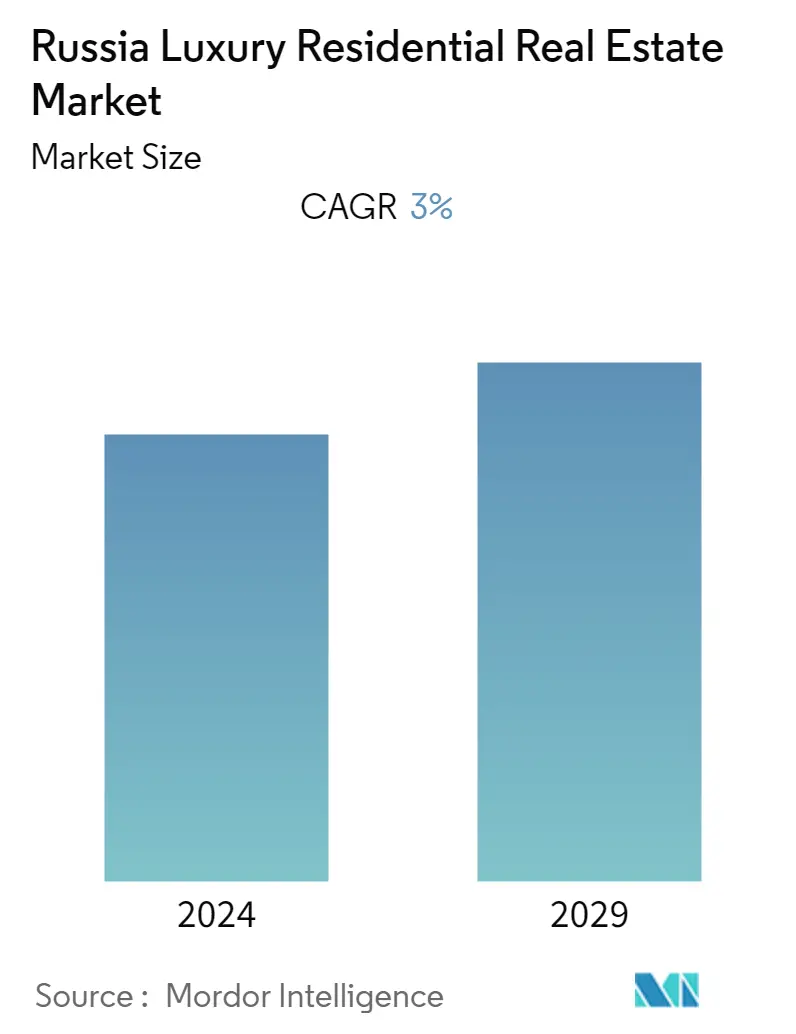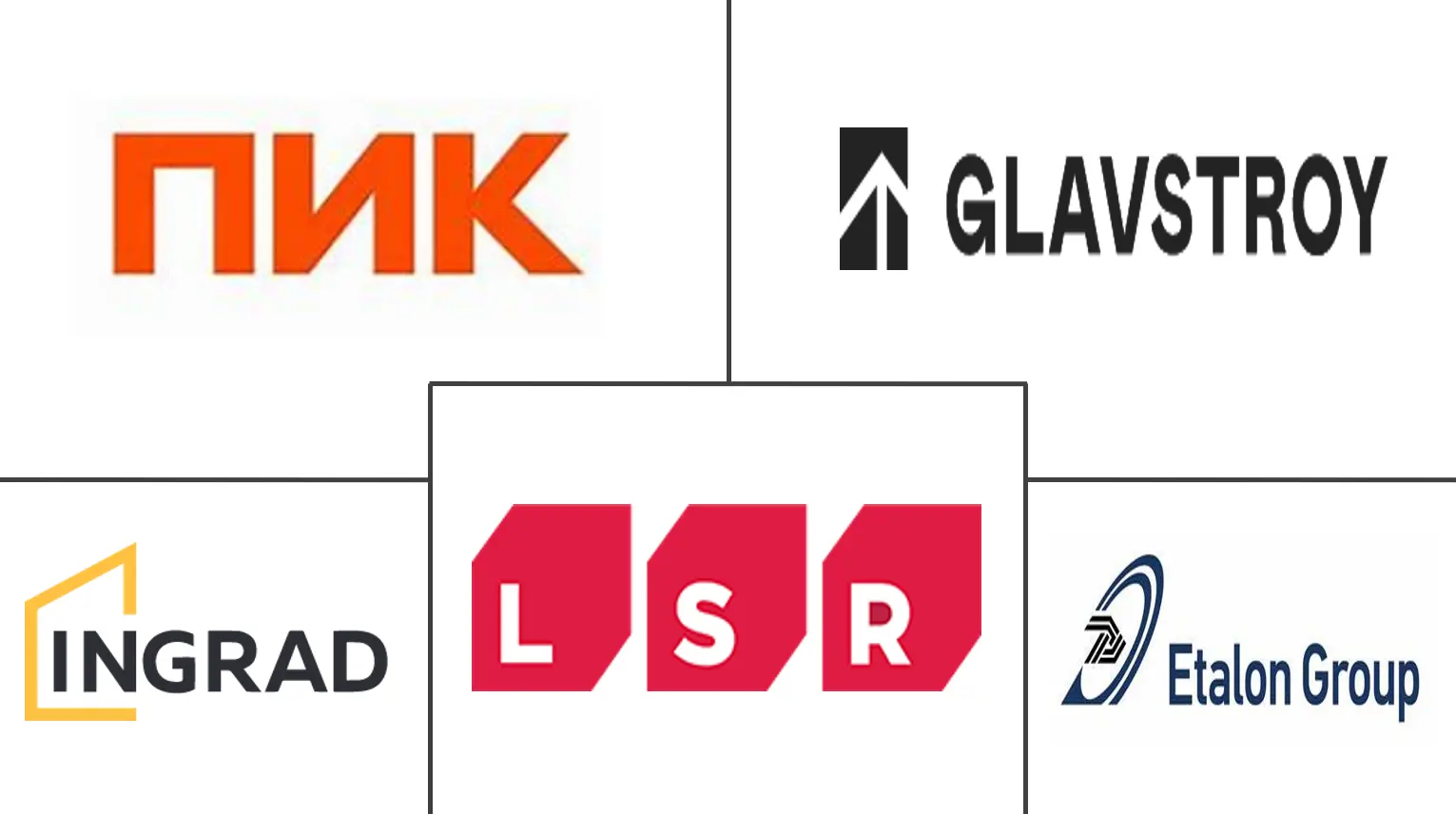Market Size of Russia Luxury Residential Real Estate Industry

| Study Period | 2020 - 2029 |
| Base Year For Estimation | 2023 |
| Forecast Data Period | 2024 - 2029 |
| Historical Data Period | 2020 - 2022 |
| CAGR | 3.00 % |
| Market Concentration | Low |
Major Players
*Disclaimer: Major Players sorted in no particular order |
Russia Luxury Residential Real Estate Market Analysis
The Russian luxury residential real estate market is expected to grow at a CAGR of over 3% during the forecast period.
The Homeownership rate in Russia has been among the highest in Europe over the past years. Amidst the coronavirus outbreak and ruble devaluation in 2020, the demand for residential real estate grew further at an average annual 12 percent, leading to increased housing prices. The pandemic effects were still notable in 2021.
The highest average selling prices in the housing market were reported in the resort area of Krasnaya Polyana at over RUB 257 thousand (USD 3.1 thousand) per square meter as of May 2021. Moscow ranked a close second with an average selling price exceeding RUB 250 thousand (USD 3 thousand) per square meter. However, in the most expensive district of the capital - Ostozhenka, the square meter price was nearly twice as high as the city average.
The Russian-Ukraine War is likely to have an impact on the Russian residential real estate market. The luxury residential real estate market for vacation and luxury homes is likely to be the first sector impacted. These purchases are easier to delay and draw a larger part of the financing from the volatile financial markets.
Russia Luxury Residential Real Estate Industry Segmentation
Luxury residential real estate is defined differently across different areas, as property values, median resident income, and area development vary widely depending on the metro area. The Russian luxury residential real estate market is segmented by Type (Apartments and Condominiums and Villas and Landed Houses) and City (Moscow, St. Petersburg, Novosibirsk, and Other Cities). The report offers market size and forecasts for the Russian luxury homes market in value (USD Billion) for all the above segments.
| By Type | |
| Apartments and Condominiums | |
| Villas and Landed Houses |
| By Cities | |
| Moscow | |
| St. Petersburg | |
| Novosibirsk | |
| Other Cities |
Russia Luxury Residential Real Estate Market Size Summary
The Russian luxury residential real estate market is poised for growth, driven by a high homeownership rate and increasing demand despite economic challenges such as the coronavirus pandemic and ruble devaluation. The market has seen significant price increases, particularly in high-demand areas like Krasnaya Polyana and Moscow, where luxury properties command premium prices. The ongoing geopolitical tensions, such as the Russian-Ukraine war, are expected to impact the market, especially in the luxury segment, as these purchases are often influenced by broader economic conditions. Major developers like PIK Group and LSR Group are actively expanding their portfolios, contributing to the market's dynamic nature.
The market is characterized by a fragmented landscape with numerous players, including prominent companies like Glavstroy and Ingrad, who are engaging in joint ventures to strengthen their market position. The rise of digital platforms and social media has transformed the buying process, making it easier for informed buyers to access property listings and engage with real estate agents. This shift has led to increased market activity and competition, with new investors entering the scene. The construction of multi-apartment buildings is particularly notable in Moscow and St. Petersburg, reflecting the ongoing demand for luxury residential properties in these urban centers.
Russia Luxury Residential Real Estate Market Size - Table of Contents
-
1. MARKET DYNAMICS AND INSIGHTS
-
1.1 Market Overview
-
1.2 Market Dynamics
-
1.2.1 Drivers
-
1.2.2 Restraints
-
1.2.3 Opportunities
-
-
1.3 Value Chain/Supply Chain Analysis
-
1.4 Industry Attractiveness - Porter's Five Forces Analysis
-
1.5 Current Economic Scenario and Consumer Sentiment
-
1.6 Luxury Residential Real Estate Buying Trends - Socioeconomic and Demogpaphic Insights
-
1.7 Government Initatives, Regulatory Aspects for Residential Real Estate Sector
-
1.8 Insights on Size of Real Estate Lending and Loan to Value Trends
-
1.9 Insights on Interest Rate Regime for General Economy, and Real Estate Lending
-
1.10 Insights on Capital Market Penetration and REIT
-
1.11 Impact of COVID - 19 on the Market
-
-
2. MARKET SEGMENTATION
-
2.1 By Type
-
2.1.1 Apartments and Condominiums
-
2.1.2 Villas and Landed Houses
-
-
2.2 By Cities
-
2.2.1 Moscow
-
2.2.2 St. Petersburg
-
2.2.3 Novosibirsk
-
2.2.4 Other Cities
-
-
Russia Luxury Residential Real Estate Market Size FAQs
What is the current Russia Luxury Residential Real Estate Market size?
The Russia Luxury Residential Real Estate Market is projected to register a CAGR of 3% during the forecast period (2024-2029)
Who are the key players in Russia Luxury Residential Real Estate Market?
PIK Group, Glavstroy, LSR Group, Ingrad and Etalon Group are the major companies operating in the Russia Luxury Residential Real Estate Market.

